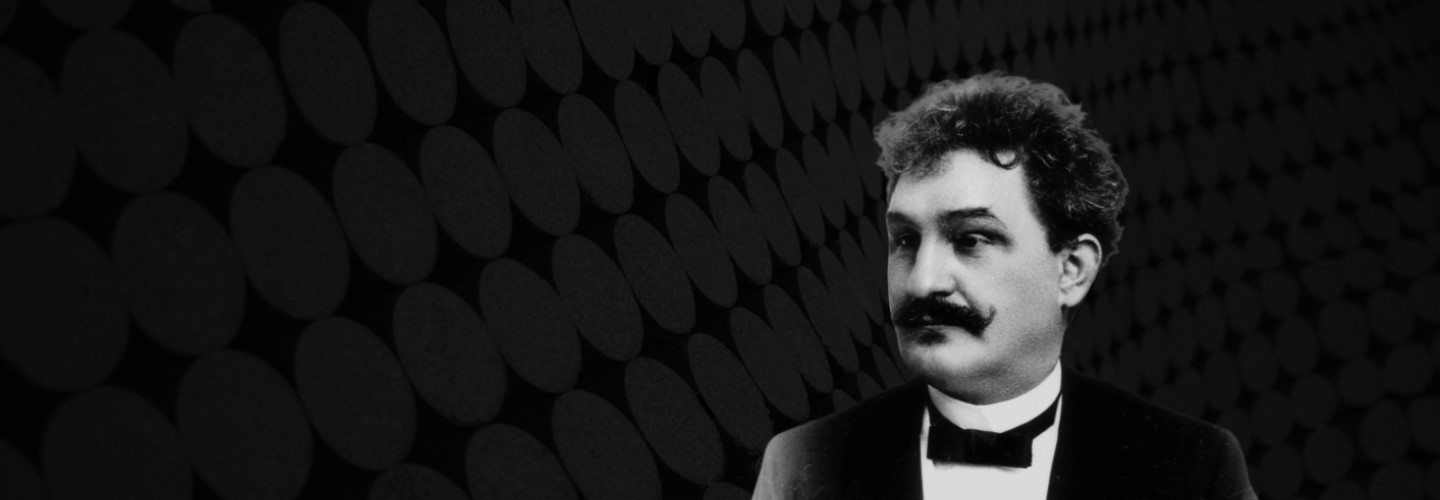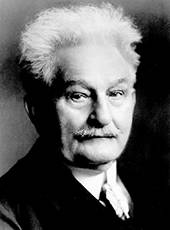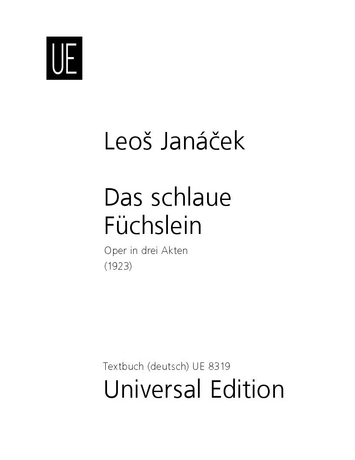

Leoš Janáček
The Cunning Little Vixen
Short instrumentation: 4 3 3 3 - 4 3 3 1 - timp, perc(2), hp, cel, str
Duration: 110'
Übersetzer: Peter Brenner, Ute Becker, Norman Tucker, Hans Hartleb, Alena Wagnerová, Fedele D´Amico, Gisella Selden-Goth, Max Brod
Text von: Rudolf Tesnohlidek
Klavierauszug von: Bretislav Bakala
Libretto von: Leoš Janáček
Choir: choir (SATB)
children's choir (SA)
Roles:
Forester
baritone
Forester's wife (Owl)
alto
Schoolmaster
tenor
Parson (Badger)
bass
Haraschta (vagabond)
bass
Pasek (innkeeper)
tenor of chorus
Vixen
soprano
Mrs. Pasek (innkeeper's wife)
soprano of chorus
Fox
soprano
The young vixen
children's soprano
Franzl and Seppl
sopranos of chorus
Dog
mezzo-soprano
Cock
soprano
Headhen
soprano
Cricket
Grasshopper
Frog
Fly
children's voices (soprano)
Dragonfly
Hedgehog
Squirrel
Forest animals
Ballet
Woodpecker
alto
Mosquito
tenor
Badger
bass
Owl
alto
Jay
soprano
Instrumentation details:
1st flute
2nd flute
3rd flute (+picc)
4th flute (+picc)
1st oboe
2nd oboe
cor anglais
1st clarinet in Bb
2nd clarinet in Bb
bass clarinet in Bb
1st bassoon
2nd bassoon
3rd bassoon (+cbsn)
1st horn in F
2nd horn in F
3rd horn in F
4th horn in F
1st trumpet in F
2nd trumpet in F
3rd trumpet in F
1st trombone
2nd trombone
3rd trombone
tuba
timpani
percussion(2)
harp
celesta
violin I (18)
violin II (16)
viola (14)
violoncello (12)
contrabass (10)
Janácek - Das schlaue Füchslein
Printed/Digital
Translation, reprints and more

Leoš Janáček
Janá?ek: The Cunning Little VixenType: Libretto/Textbuch
Language: Englisch (Großbritannien)

Sample pages
Audio preview
Work introduction
The tale of the free-thinking and crafty vixen Bystrouška goes back to the 1890s. In the beginning were the tiny sketches of the painter and forester Stanislav Lolek (1873–1936), a distinguished landscape artist. The story of Bystrouška was serialized in Lidové noviny from 7 April to 23 June 1920 and had a huge success. The merry and immediately accessible drawings with a witty and topical text found a readership throughout the entire social spectrum. It is certainly true that Janáček began considering composing an opera on this theme since he acquired cuttings of all the episodes in Lidové noviny. And in fact, as soon as Janáček completed the work on Katja Kabanowa he immediately started on Das schlaue Füchslein. The dates on the autograph show that he began composition as early as January 1922. The author of the literary model Těsnohlídek got the news only indirectly that Janáček wanted to compose an opera on his text. The composer himself invited him to come and see him at the time when he was already working on the opera.
Meanwhile Janáček composed, and started out on his study of nature to a whole series of bird notations – of thrushes, sparrows, finches and blackbirds. He wrote down notations for doves, a little toad, and a frog with the instrumental comment ‘like a xylophone’. He also noticed animals and took down in his notebook his impressions of walks in the game reserve, where the forester even tracked down a vixen’s den with young so that the composer could observe and study them. No wonder that several of Janáček’s newspaper reviews in Lidové noviny in the years 1921– 1922 had animal motifs.
Meanwhile frantic negotiations broke out over who would publish the composer’s latest work. As in the case of Jenůfa, Die Ausflüge des Herrn Brouček and Katja Kabanowa, interest was shown essentially by two publishers: Hudební matice in Prague and Universal Edition in Vienna. The first to approach the composer was Hudební matice, but, as before, Janáček used this offer rather as a tactic to firm up his dealings with Universal Edition. The contract with Universal Edition was signed between March and April 1924.
The celebrated world premiere of the opera Příhody lišky Bystroušky (Die Abenteuer des Füchsleins Schlaukopf) took place in the Brno theatre Na Hradbách on 6 November 1924. The reception was tremendous and the composer himself was happy with the staging by Ota Zítek and the set design by Eduard Milén (who also designed the cover of the piano vocal score).
The composer himself characterized the opera as a forest idyll, one that would awaken the notion of the unity of life – both human and animal.
